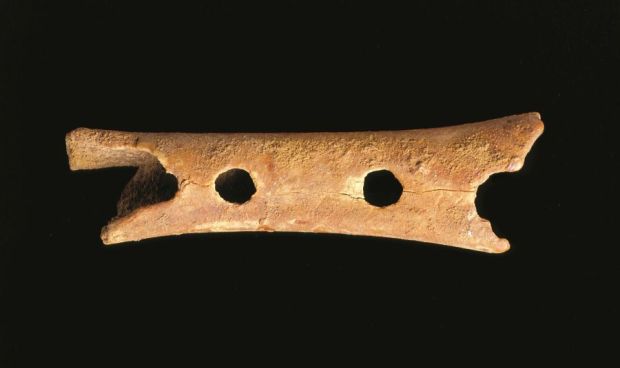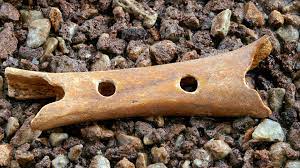RECORD STORE TALES #929: “The Neanderthal Flute”
When Beethoven invented music in 334 BC, he had no idea we would owe him a debt of gratitude over two millennia later. When his friend, Presley of Elvis, heard this wonderful sound, he decided to pin some strings to a piece of wood and created the first guitar.
That’s how it all started right? Beethoven, Bach, Elvis, the Beatles?
Music has likely been with us since the dawn of abstract thought. Ancient evidence is difficult to find, since most musical instruments would have decayed to nothing over tens of thousands of years. Without physical remains, an “invention” of music is difficult to date. Even musical notation came much later. According to Dr. Kathryn Ladano at Wilfrid Laurier University, those who played ancient music “were improvisers. Improvisation has to be the oldest and first form of music, before anything was written or passed down in the oral tradition.”
The oldest musical artefacts we have are flutes made of bone. The most ancient of these could be the 45,000 year old Divje Babe flute, discovered in Slovenia in 1995. It was dated using the Electron Spin Resonance (ESR) technique. The bone is commonly called the “Neanderthal flute” but there is no consensus on who made it…if anyone. If indeed it is a flute, it would be the oldest known musical instrument ever found.
There are other, younger known bone flutes, but the Divje Babe femur would be the most ancient found by far. What we do know with certainty is very little. It has never appeared on a Jethro Tull album for one thing, which is truly unfortunate. The Divje Babe flute is a broken juvenile cave bear bone, with two clear holes, and possibly the remains of two more at either broken end. Bones with holes in them are common. Rather than a flute, it could just be a fluke – a piece of bear femur, pierced by the teeth of a predator.
We have theories. Was the bone just left as-is by an animal? Both ends are damaged, probably by a predator looking for the tasty marrow inside. Tests were made with metal castings of various predator teeth. The hole alignment does not match any known animal’s teeth, but the holes could have been made at different times rather than simultaneously. Canadian musicologist Bob Fink thinks it unlikely that such a situation would result in four holes in a straight line. Tests also showed that bones often broke when trying to duplicate an animal bite. Finally, we can’t rule out that the holes could be a modern hoax, nor can we rule out Ian Anderson as a suspect.
As humans, we hope the bone is the first known musical instrument and there is some evidence to support that. For one, the bone appears to be cleaned of marrow, since the inner and outer surfaces are the same colour. This would be necessary if it were a flute. The holes are also quite circular, which is unlike most oval-shaped bite holes. There are no marks on the bottom of the bone, which you would expect if it was between an animal’s jaws. It takes a lot of pressure to bite a hole in a bear femur. However there are also no tool marks, which are common on actual man-made bone flutes.
Here’s the most interesting evidence, if not the most compelling. According to Fink, the four holes line up with the “do, re, mi, fa” of the diatonic scale. Can you imagine? 45,000 years ago, somebody playing “do re mi” on a bone flute. Perhaps for ceremonial, religious reasons. Maybe just to entertain the tribe with a hit song. Binding communities together, person by person. Expanding the capabilities of the human brain one note at a time. The same scale we play today.*
Before you get too excited about the possibilities, the bone is a juvenile cave bear and would not have been very long even before it was broken. One study (by Nowell and Chase) indicates that the bone would have had to be twice its natural length to play the diatonic scale. Fink countered this with the possibility of an added mouthpiece that extended its length.
Why not use modern technology to create a replica flute and try to play it? In 2011, Matija Turk and Ljuben Dimkaroski did just that. Their study showed “it was possible to perform a series of musical articulations and ornamentations such as legato, staccato, double and triple tonguing, flutter-tonguing, glissando, chromatic scales, trills, broken chords, interval leaps, and melodic successions from the lowest to the highest tones.” Furthermore Dimkaroski found that a longer bone was not necessary to play music. The reconstructed instrument had a three and a half octave range and was less like a flute and more akin to modern woodwinds.
One of the most fascinating aspects of the flute is that it could have been made by our Neanderthal cousins, which would prove that music is a trait shared by two species and not just ours. Even if the bone really was carved by Neanderthals, there is no way for us to know for certain. It could have been left in the cave much later on by a wandering human.
We do not have all the answers yet, but the possibility of the same musical scale that we use today being at least 45,000 years old is an enticing one. It sets the imagination on fire with possibilities. You could go back in time and play “Heartbreak Hotel” on this ancient flute in that dark cave, if the theories hold true. What an incredible thought that is.
* Dr. Ladano notes, “Even if it didn’t match with the western major or minor tonal system, it isn’t any less valid. Other cultures use different scales and maybe the maker of this flute used a different scale system as well.”




That was a fascinating history lesson Mike. Thanks
LikeLike
Thank you! Trying to get back into the kind of writing I did pre-pandemic.
LikeLiked by 1 person
That was fun! I feel like I went to a college class especially since you quoted a very famous Professor in Dr. Ladano! Great stuff Mike!!
LikeLiked by 1 person
Thanks John! She was a last minute addition. I was polishing it up last night and I thought “I wonder if Dr. Kathryn has anything to add…”
LikeLiked by 1 person
Very interesting read. Enjoyed that!
LikeLiked by 1 person
Sorry it wasn’t about a “Tee” bone!
LikeLike
Pretty sure it was a “T” before it was broken. I have my own theories. 😂
LikeLiked by 1 person
It was originally supposed to be a bone guitar….
LikeLiked by 1 person
The TeeBone Flutar. Way ahead of it’s time.
LikeLiked by 1 person
So far ahead of its time we still haven’t figured it out!
LikeLiked by 1 person
Me and a buddy have a long running joke about who has the bigger “flute” so this is probably way funnier to me. Lol.
LikeLike
Man, I love this kind of thing. Music is the universal language, makes sense it’d show up so early.
LikeLiked by 1 person
There’s another great subject. Music as the universal language.
LikeLike
I think it is. Because music is math. And math is behind everything. And music holds the beauty. And so on.
LikeLiked by 1 person
I’m actually working on something unrelated to that, but does relate to the math of music. The relationship between pitch and length of string.
LikeLike
Absolutely. Tension, vibration, oh yes. That… that sunded sexual lol. Maybe it was and I need to get out more!
LikeLike